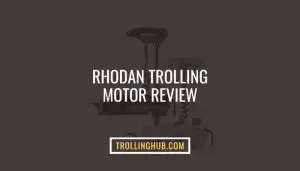Since the species of mahi mahi are easily found in almost all water bodies, it’s pretty trouble-free fo trolling for Mahi. Yet, there are some must-have tactics to follow to be successful.
For instance, ensure you have some spinning rods set up while trolling for Mahi. It will help you target the entire school alongside the surface. Another essential technique is avoiding heavy tackle because it will overpower this species and can grab you to be failed. Instead, you should use light tackle.
So, if you want to explore more essential tips and tricks to troll for mahi, go through the entire article. We’ve researched the 10 best tactics for you.
Do Mahi Mahi Fight Hard?
Mahi is considered the best fighting fish when a few numbers of species can compete with them. In terms of their pure fighting ability, they like moving sideways into the water, making it difficult to catch them.
It gets its fight rating of 9/10, which is a good fight when you hook a mahi. However, these species can rip a ton of line, and their fight seems shorter than the other fish. Once the fight is over, remember that mahi is almost dead in the water.
Since mahi mahi are too fast and respond violently to the lures, you must be careful while hooking. Because mahi is strong enough to pull the entire line off the spool, which can be a massive inconvenience for you.
Trolling For Mahi: 10 Effective Techniques
Mahi Mahi is also called dorado and dolphin based on different locations. There are two best techniques for fishing mahi, one is trolling, and another one is site casting.
Trolling for Mahi is the most effective strategy than the site casting strategy.
Mahi Mahi is a relatively good saltwater species that rarely exceeds thirty pounds. But, in some cases, you can find Mahi up to 88 pounds max.
This species can grow anywhere and get a 3 to 6-foot-long size. Considering their size, it’s easy to catch them using proper techniques. Here are our 10 best expert tips that you can follow to build your skill-
1. Water Type
Mahi prefers to be in warm water than cold water. So, choosing a fishing area like the South Pacific, Caribbean, or Mediterranean will be your right decision. It will also be a better fishing place in the Atlantic Ocean.
2. Floating Seaweed
Mahi mahi tends to be drawn under floating seaweeds, commercial fishing gear, or other unused boards near the water’s surface. It’s a great way to target and toss your bait next to any floating seaweed. It’s a very successful technique.
3. Choose A Strong Fishing Tackle
Although mahi isn’t that big of a fish, it’s strong as hell. So, it will require you to employ great force and effort. Therefore, we recommend you take a tackle that can be used for a long time and ensure a good backup if it breaks. Here, you can use an action rod 7 ft long.
4. Swivel and Leader Size
Choosing a barrel swivel with 50 pounds and a leader size between 3-0 to 80 pounds fluorocarbon will do your job. For bait circles, hooks with 6/0 or 9/0 are perfect.
You should use class rods and reels from 30 to 50 pounds during your trolling time. If you use a ballyhoo bait, your rig should be of 7/0 to 9/0 hook.
5. Durable Rod & Line
Anglers oftentimes hook other species while trolling for mahi mahi. And this incident is widespread and frequent. If any other fish is hooked on your lure, the line can be torn, ruining your journey. Therefore, the fishing rod and line should be highly durable.
6. Use A Bucket of Chum
Mahi mahi doesn’t just like swimming solo. This species also like to be in a large group. So, a single bait won’t be handy when targeting the entire school. Considering this, you can use a bucket of chum which creates interest easily. This method is known as the bailing for mahi mahi.
7. Daisy Chain & Spreader Bars
You must cover the targeted area to catch more fish simultaneously. A daisy chain and spreader bar will allow you to distribute the weight for more pick points. Catching the entire school of fish will be successful in terms of the daisy chain and spreader bars.
8. Get Your Bait Ready
The ideal chunk bait for mahi mahi is the ballyhoo. You can try the ballyhoo when mahi is around your boat side. Trolling with 20 pieces of ballyhoo (pre-cut) will create interest in mahi. However, not always the ballyhoo work. If you notice no bites, try casting the bucktail and retrieve it fast.
9. Get All Your Belongings Ready
There are many things that you must set before going for trolling. Here’s what you need to set-
- Fish Rag l>
- Fishing Net
- Number of Tackle Setups
- Flying fish
- Triggerfish
- Man-o-war fish
- Sargassum fish,
- Jacks
- Pompano
- Pelagic
- Different bottom living species, etc
- East Coast of Florida
- Mexico l>
- Costa Rica
- Hawaii
- Bahamas l>
- April to June is considered the peak time according to the experts. During this period, plenty of mahi will be available on the seashores or river banks, especially along the South Atlantic and Gulf Coast.
- A strong number of mahi mahi will be widely visible throughout June to August, which means the entire summer season. l>
- Surprisingly, from May to October, you’ll get this species available throughout the day and at night.
- Time right after an immediate storm is another key period to catch many mahi. The heavy bushes of debris pushed them offshore, which can be an effective strategy to catch them hassle-free.
Take a fish rag on your boat if you don’t want the blood of the mahi will make your boat slippery. Using a rag will make it much easier to grab the mahi and put it directly into the cooler.
It’s good to keep a net on the boat to lift a large school of fish effortlessly. You can lift the fish with your fishing rod, though. Sometimes it’s hard to lift. And at that time, you can easily lift the fish with the net.
You should keep at least 3 to 4 tackle setups rigged for an ideal trolling for mahi. It will assist you in controlling and organizing your trolling procedure more precisely.
10. Water Temperature
Usually, mahi likes the water temperature at around 82° Fahrenheit. But if the water temperature is below 68° F, they will also be available in that water condition. Regarding the 77° F of water temperature, their availability often stays moderate.
How Fast Should You Troll For Mahi?
According to the experts, the speed for mahi should be between 7 to 10 mph. This speed won’t let the bait blow away from the targeted area and deliver enough stability to swim into the water. This speed range is ideal even if there’s strong wind and waves.
Speed from 7 to 10 mph will allow the school of mahi to see the bait clearly. They will get enough time to check out whether the bait is biteable.
Ensure you’re not going too slow; otherwise, mahi will lose interest in biting. On the other hand, too-fast trolling will scare them. So, you’ve to be careful while determining the speed level.
Remember, this 7 to 10 mph trolling speed for mahi isn’t that hard-and-fast rule. It’s an ideal speed range that you can try. If this speed range doesn’t work, increase or decrease the speed level focusing on the fishing zone and the presence of mahi.
What Depth Do You Troll For Mahi Mahi?
The species of Mahi are the high migratory and open ocean blue-water fish. Therefore, they like to be in tropical and subtropical water bodies up to 279 ft of depth. However, you still can find them at around 121 ft of water depth. Trolling for mahi mahi following the given depth will ensure good fishing success.
Although this species is often found near grass beds, you still can find them in deeper water up to 300 ft. Usually, they like to be within 100 ft of the water column because of the availability of their meal, for example, ballyhoo, mackerel, squid, etc.
How Long Should A Mahi Troll Leader Be?
You often experience catching some other different species of fish while fishing mahi. In that case, cutting the leader a few inches back will allow you to quickly set it again for mahi. So, you require a long leader between 15 and 20 ft long.
This leader length is perfect to re-tie in a short while and re-bait it. You’ll be able to start fishing within minutes. Some anglers prefer choosing their leader with 12 ft, which seems short for mahi.
What Is Mahi Mahi Favorite Food?
The favorite food or live bait of mahi are the octopus, jellyfish, crab, and squid. Their eating habits are wide, and they eat a wide variety of ocean species. But, there are certain types that mahi mahi likes the most. For instance,
Mahi doesn’t just like to take their meal with small species of fish; they also prefer having the juveniles of large fish like tuna and billfish. Daytime is their best-preferred time to search for food on the seashore.
However, according to the South Atlantic Fishery Management Council, debris like plastic wrappers, rope and string, small light bulbs, etc., are found in the stomach of mahi, which means they like to eat debris sometimes.
Where is The Best Place to Fish for Mahi Mahi? 5 Best Places
The Mid-Atlantic coast is the best place to get plenty of mahi when its water is warm. However, commercial fishing spots are the most popular place to find a large group of mahi. Keep these places on your list before you go out.
Considering the tropical and temperate water surfaces, you’ll find mahi worldwide. The inshore areas are also the ideal place to find the large school of mahi. Here‘s a list of 5 of the top fishing spots for mahi-
If you want to get the highest traffic for mahi during winter, visit Florida. Mahi Mahi migrates to this place from Carolinas and presents an average of 10 pounds of fish in winter. Also, trolling for mahi in south Florida will be an excellent place for fishing.
One of the best and most highly recognized places for mahi is Mexico. Go there for fishing between May and December, and you will enjoy your non-stop catches.
The richest coastlines of Costa Rica come with some excellent places for mahi. If you live in Costa Rica, planning to troll in the Gulf of Papagayo, Tamarindo, Quepos, Caribbean, Samara, etc., will be your best bet.
Another popular place for mahi is Hawaii. The abundance of baitfish and the warm water is why this place is so famous for mahi.
This place is considered the home of Mahi because of the plentifulness of this species. The Bahamas comes in the top fishing records consistently. So, you can choose this amazing place for trolling for mahi.
How Far Out Do You Fish for Mahi Mahi?
You can notice the presence of mahi up to 10 miles from the shoreline. When the shallow continental water begins to warm, mahi swims near the shore, which makes them visible within 10 miles max. This species will also be found closer to the coast in a depth of 0-279 ft water.
Besides, you can see the mahi in the closer hunting ground or the hiding place (offshore warm water) covered with seaweed that floats well visibly.
Best Time to Catch Mahi Mahi
Mahi can be available almost year-round. However, you can catch comparatively more mahi during their spawning time from February to June. Mahi chooses drop-offs or near-cut banks for spawning. So, these places are well-targeted from February to June.
However, what is the best time to fish for mahi mahi? Well, considering the warmth of the water’s surface, they remain highly active in the afternoon.
This timing works best in almost all seasons except summer because of its scorching temperature. So, do Mahi bite in the afternoon? The answer is yes.
What are The Best Lures for Mahi Mahi?
Compared to other species, mahi comes with quite a different point of view in deciding their bite. They don’t just get attracted to colorful and shady lures and go to bite.
So, don’t expect mahi to surrender your beautiful lures or fishing gear so quickly.
Instead, they will put up an intense fight before they are trapped. So, if you want to stake a large number of mahi a day of trolling, check out the 3 top suggested lures that are exceptionally designed for mahi-
1. MagBay Mahi Lure
It’s an 8 Inches rigged Mahi lure that will make your entire trolling journey great fun. This lure is designed not to fall off your kite; you can apply it as teasers in the spread.


The MagBay lure for mahi is customised with a vast pricker treble hook and SS wire. It will provide a 150 lbs Monofilament.
2. OCEAN CAT Offshore Lure for Mahi
Very few lures are manufactured with multiple options of colour, length, and hook. However, the Ocean Cat offshore saltwater lure will be available in six designs with multiple colours and lengths. It will deliver 150 lbs of leading force, allowing you to ensure good trolling for mahi. Amazingly these lures come with an elegant bag to carry them inside.


Thai lure will be available with three head designs Jet head, Crystal head, and Copper head. And they will be weighed with lead weight inside. When you go for high-speed trolling, the Ocean Cat will move vividly, like real fish. It will seem real due to its water splash types and 3D eyes.
The Ocean Cat has sharp corners and several hooks for trolling convenience. So, you should be careful while handling it. Because its sharp corners can hurt you.
3. CAPT JAY FISHING Lure for Mahi
This ultra-strong lure is designed to hook mahi quickly. Capt Jay has a few detector holes in its gold head, making it the best bait for mahi mahi.
And these detectors are included to allow the lure to move in a more realistic way under the water. As a result, its dynamic motion quickly gains the faith of mahi to make their bite with a little fight.


It’s designed with various shiny trolling skirts for mahi to enhance attractiveness. So, this fishing gear will pop amazingly and run well for a successful trolling experience. And its stainless hooks are explicitly added for offshore fishing.
In terms of the sharp needle point tip, Capt Jay can hook the mahi effortlessly. It can be rigged with a 300lbs steel wire leader with reinforced double hooks.
As the Ocean Cat lure, Capt Jay is also designed with sharp corners, and it can be dangerous unless you use it carefully.
What is The Best Fishing Line for Trolling Mahi Mahi?
Commonly fishing lines from 20 to 30 pounds are used for mahi. The test monofilament fishing line with 20 pounds or more is the ideal bet for mahi.
Anglers who use the charter boat sometimes prefer fishing lines from 50 to 80 pounds. The professionals strongly recommend the monofilament fishing line between 20-30 lbs for the strong species mahi.
However, spooling the reels with fishing lines up to 25 lbs will be more convenient if you need to spin the reels. On the other hand, the conventional trolling reels require you to go for the 30-lb monofilament.
If you’re a beginner, you must also look for techniques to troll some other species, for instance, trolling for trout. So, check out the 10 best techniques to try while fishing this delicious species.
FAQs
No, Mahi is the top feeders, and they like to eat on top of the surface water most of the time. But sometimes, they search for the bottom-living species for their meal. It varies depending on the fishing zones and bait availability.
Mahi can swim up to 300ft deep maximum. But, it can be found in 121 ft as well.
Well, a 40-pound mahi comes with around 4 inches of length. And a baby mahi takes a week to grow to 1.3 to 2.7 inches in length. It means a 40-pound of mahi is a 1-year-old fish.
iv>On 1st January 1982, a man named Monte Green caught a 77-pound mahi which is still the biggest one anyone has ever caught. He was trolling off Florida (Islamorada) using ballyhoo on that day.
There’s no significance in applying outriggers to ensure effective trolling. However, if you troll without outriggers, you must be aware of where to set the lures for precise fishing.
Final Thoughts
Before you go trolling for mahi, you should study the nature of mahi, focusing on what they prefer to eat, what time they swim offshore, and many other significant factors. Knowing this info about mahi will help you decide where and how to troll effectively.
But, if you’ve no time to research, here we are. We have covered all the essential factors that will clarify your thoughts about mahi within a short while.
So, don’t forget to double-check our shared techniques if you have a boat and want to go offshore for mahi. Following our techniques will help you be successful with less effort.



